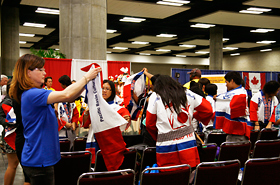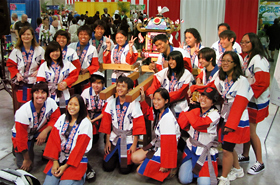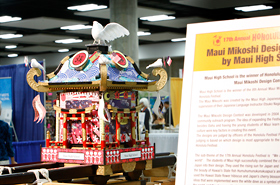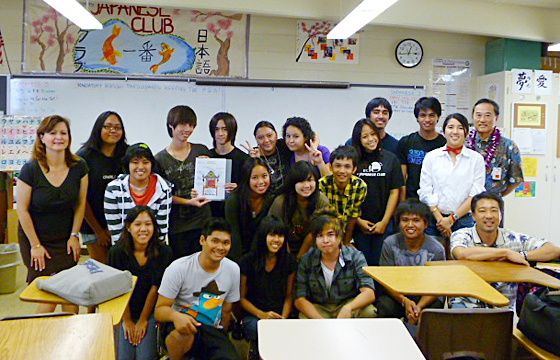Q: What was the process including timeline that that you applied with your students to produce your winning Maui Mikoshi design for the 8th Annual Competition?
I mentioned the Mikoshi contest to my Japanese club officers and they were excited about entering the contest to defend their title as Mikoshi design winners. I showed the Japanese club students a video on “Japanese Festivals” and explained to them what it is, and about the Mikoshi contest. Subsequently, my Japanese club students were enthusiastic and determined to enter the contest without hesitating. It was the possibility of winning the contest and marching in the Honolulu Festival parade. We only had two and half weeks to come up with the design, my students met every day during the school week (during their lunch time) in my classroom. At first, my students brainstormed this year’s theme, “We are Neighbors around the World.” The ideas were categorized according to what part of the Mikoshi they were going to be. Then they voted on which idea will be best for a cretin part of the Mikoshi based on the theme. The students were allowed to vote once per category. The most popular idea was the walls with two parallel sides that had a koi fish, and the other two parallel sides with the Humuhumunukunukuapuaa. The students went over each and every idea and eliminated the minority voted ideas that didn’t fit the theme. When they finish with the ideas and brainstorming, the officers place the students in groups of three or four to draw parts of the Mikoshi containing their ideas. After we finish drawing we had one of my officer and a few students that is in graphic designing using Photoshop to illustrate the design. At the end, we successfully finish with a smile.


Q: What are some of the ideas that came up from the students when discussing the sub-theme “We are Neighbors around the World?”
Our main objective was to have countries around the world that shows harmony and passion by showing customs and common ground that they all share. We based everything on what all countries have like flags, languages/writing, and people but also on what they share like the world and peace/harmony (which the dove represents). When we put all the ideas together it shows we are all neighbors around the world. We had many different countries with their flags on the corners of the roof and have different writing on the poles. We place the net people that are holding hands draping down to show that everyone are friends here on this earth. In this world we share the earth, so the world is mapped on the roof to show all countries are together as one. The dove on top the roof shows the peace and harmony around the world.
 This design also has a story behind the ideas. From top to bottom shows the peace and harmony of the world, then branch off to the countries around the world which the flags and the writing represents, as it comes down to the walls its shows the friendship between Hawaii and Japan, and last comes to the net people around the world to show unity to all. In choosing what we put on the Mikoshi we made sure that the objective chosen is a mainstay of the world’s harmony, unity, and tranquility of being neighbors.
This design also has a story behind the ideas. From top to bottom shows the peace and harmony of the world, then branch off to the countries around the world which the flags and the writing represents, as it comes down to the walls its shows the friendship between Hawaii and Japan, and last comes to the net people around the world to show unity to all. In choosing what we put on the Mikoshi we made sure that the objective chosen is a mainstay of the world’s harmony, unity, and tranquility of being neighbors.
Q: What are some of the “hot” topics that your students really get into when teaching the Japanese language and culture?
My students look forward to learning about how the Japanese culture differs from their own culture here in America. Things like festivals and holidays really interest the students. They enjoy discovering the different traditions that take place in Japan. When we are covering the culture notes at the end of every lesson it becomes the talk of the class. Not to mention, the language is an enjoyable subject that the students like to dive into. Creating the mikoshi design created a fun learning environment for the students. After finishing the design they gained knowledge about the history, celebrations and norms of the Japanese culture.
Q: What do you think that the students get most out of participating in this event?
What the students get out of participating in this event is the first-hand experience of creating and partaking in a Japanese related event. Our newer students who haven’t joined us last year in the parade have gained knowledge through the introductory and creation of this project to learn about what a Mikoshi is. So it’s a learning experience as well. Also, the students learned about how to use time considerately when working together to create the Mikoshi and that really helped the designing event deem enjoyable for everyone.








